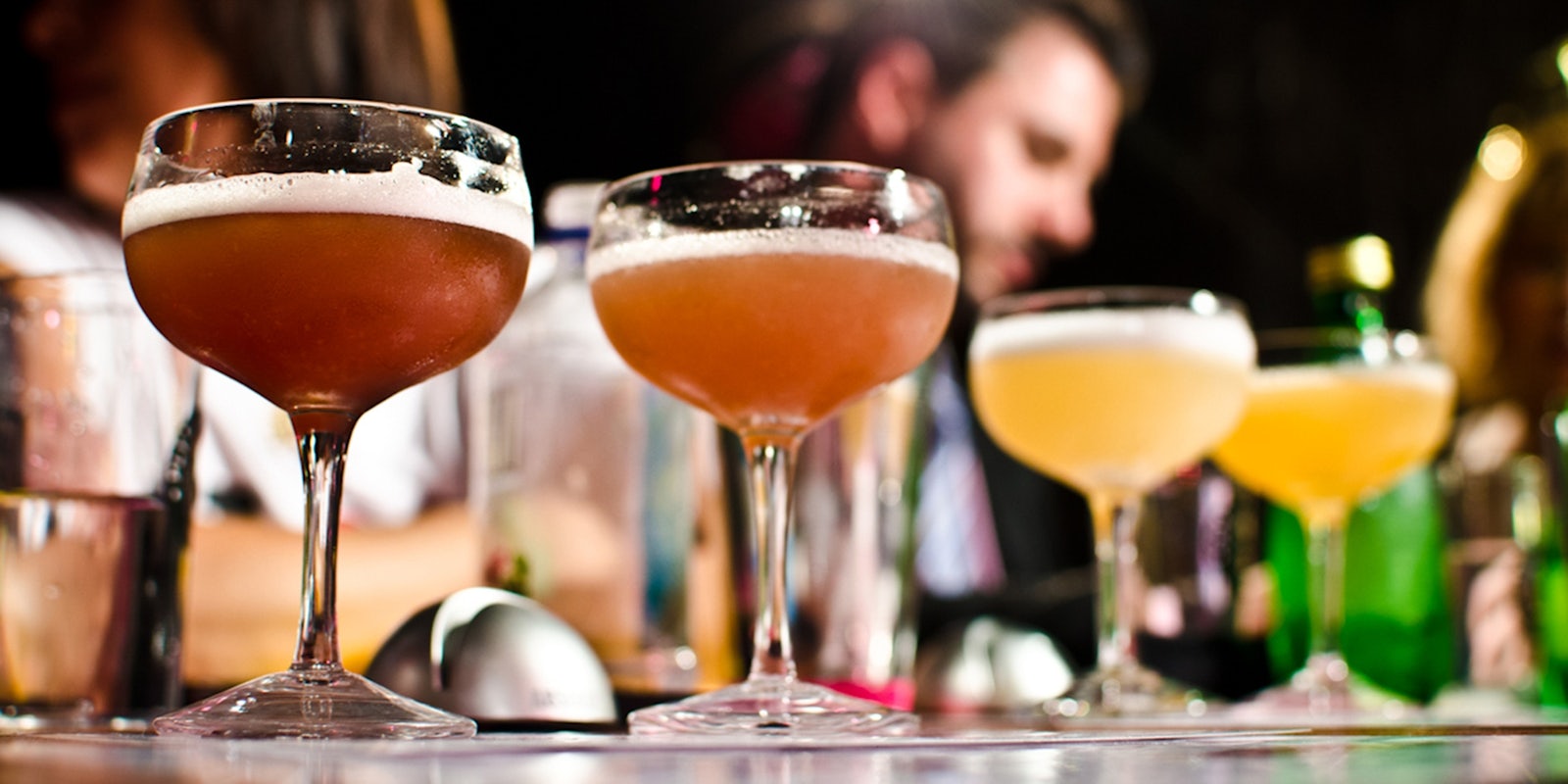“I don’t trust these robots,” the long-haired guy next to me says while sipping a glass of draft beer. He got it at the bar behind us, from a human bartender. I, on the other hand, am holding a tiny Manhattan that has been mixed by a robot, dispensed through the phallus of a whimsical fountain fixture. Astonishingly, this has not deterred me from drinking it. It’s a little heavy on the bitters.
I’ve come to the DNA Lounge in San Francisco for the Cocktail Robotics Grand Challenge, where homemade robots will prepare cocktails of wildly varying quality to the delight and amazement of a few hundred attendees. The robots will be judged in four categories: Style and Grace (how clever and dapper is it); Efficiency of Intoxication (are the drinks any good); Full-Assery (does it work or does the botmaker incessantly tinker); and, my favorite category, This Will End Badly (extra consideration for “terrible ideas and Mad Science”). The judging panel is made up of Carter Wilson from KIXEYE, Kristine Wagner, Cool Science Lady, and Doug Dalton, co-owner of several of my favorite bars in San Francisco.
There are 14 bots competing, each with a clever name and enticing description: PAC 2.0 is described as “a robotic Tupac Shakur tribute.” Tipsy Bot urges me to “LEGO of my inhibitions,” and, most intriguingly, a robot simply named Karen and described as “a dirty girl!” I am very excited to meet Karen.
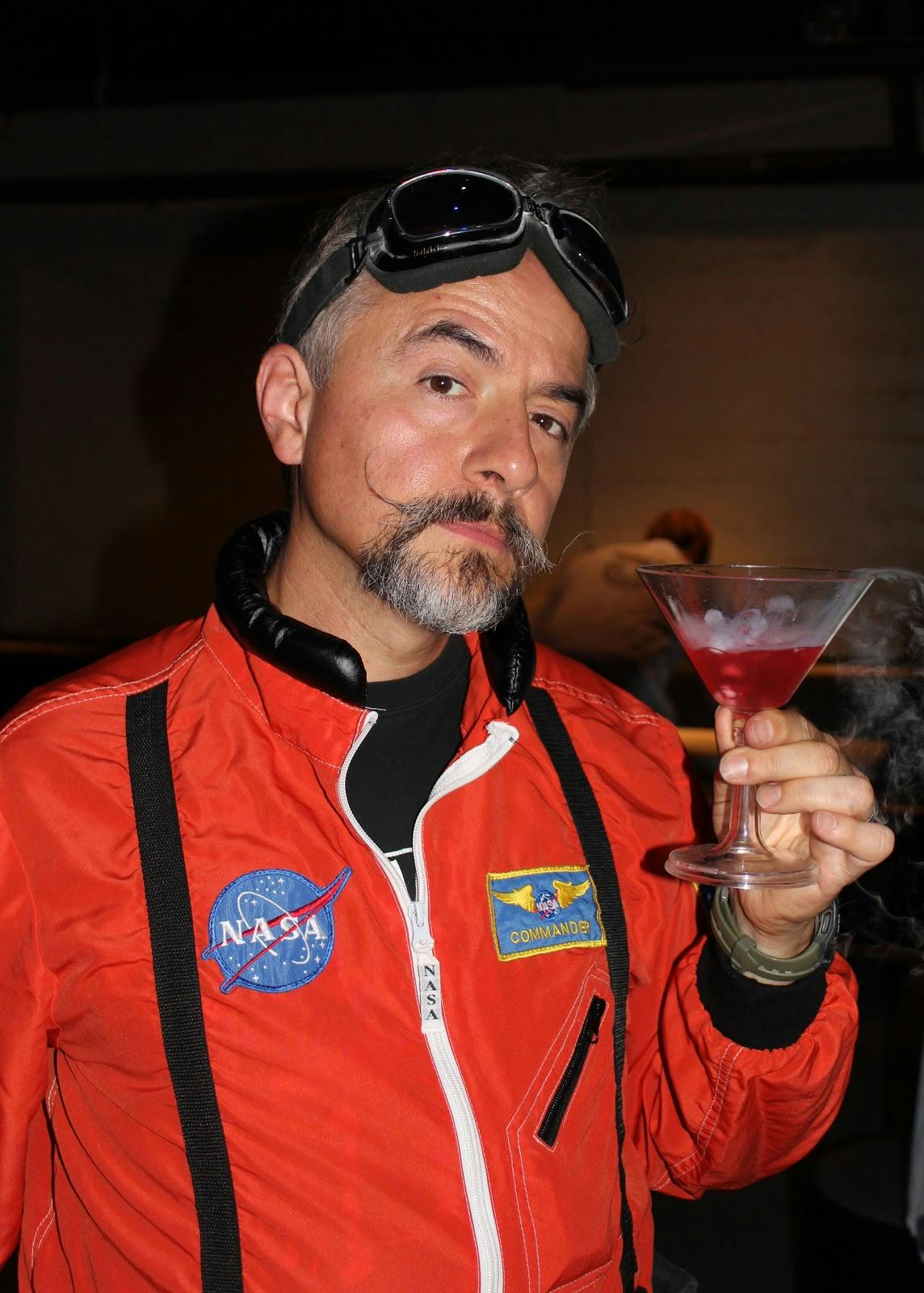 The first person I see when I walk into the room is wearing a full-body orange NASA spacesuit, holding a cosmopolitan that’s billowing dry ice smoke over the edges of a martini glass. He looks like Robin Williams in The Birdcage wearing Dustin Hoffman’s mustache from Hook. He is Sam Coniglio, creator of the Cosmobot, and he is the maddest scientist I will meet tonight.
The first person I see when I walk into the room is wearing a full-body orange NASA spacesuit, holding a cosmopolitan that’s billowing dry ice smoke over the edges of a martini glass. He looks like Robin Williams in The Birdcage wearing Dustin Hoffman’s mustache from Hook. He is Sam Coniglio, creator of the Cosmobot, and he is the maddest scientist I will meet tonight.
Sam tells me that Cosmobot has been around since 2009, when he created it for the RoboGames’ “Cocktail Robotics” category, and that every year since then they’ve been improving on the bot and fine-tuning its capabilities.
“San Francisco is unique because it’s a beautiful combination of engineering and art,” Sam says. “When you get artists and engineers working together, magic happens.”
The Cosmobot is designed to look like a 1950s-era rocket ship, and is operated in a delightfully hands-on manner with dials and a big red launch button that sets the drink in motion. This year Sam has added multi-colored lights throughout the body of the rocket to light up the drink sequence.
At the top of the rocket ship are four valves and a fish tank air pump. The air pump pressurizes the “fuel tanks” (mason jars) inside the ship that contain the drink ingredients. Once the tanks are pressurized, each valve opens for a precise number of milliseconds and dispenses each ingredient. The team worked with a bartender to set the timing for each ingredient because, as Sam tells me, “you don’t want to overdo it in any way.” I nod the nod of an adult who is about to knowingly get drunk at a very early hour on a Sunday.
Unable to resist the flashy neon light tubes and sleek retro design of the Cosmobot any longer, I excitedly crank the dial to the cosmopolitan setting and press the big red button. “COSMOBOT PREPARE TO LAUNCH!” Sam yells as he places my cup under the rocket. “I’m going to be saying that all night,” he confesses. The machine whirs into motion and I watch as the ingredients are poured one by one, passed through a cooling chamber, and dispensed into my cup.
“Our secret weapon is dry ice,” Sam says.
The Cosmobot’s output is pleasantly vodka-heavy. “How drunk did you get during the testing stages?” I ask between sips. “A lot,” Sam replies. “We asked for volunteers to assist. The funny thing about the hobby-robotics world is they’re not really alcoholics, so it was really hard to find someone who understood what a good cosmo tastes like.”
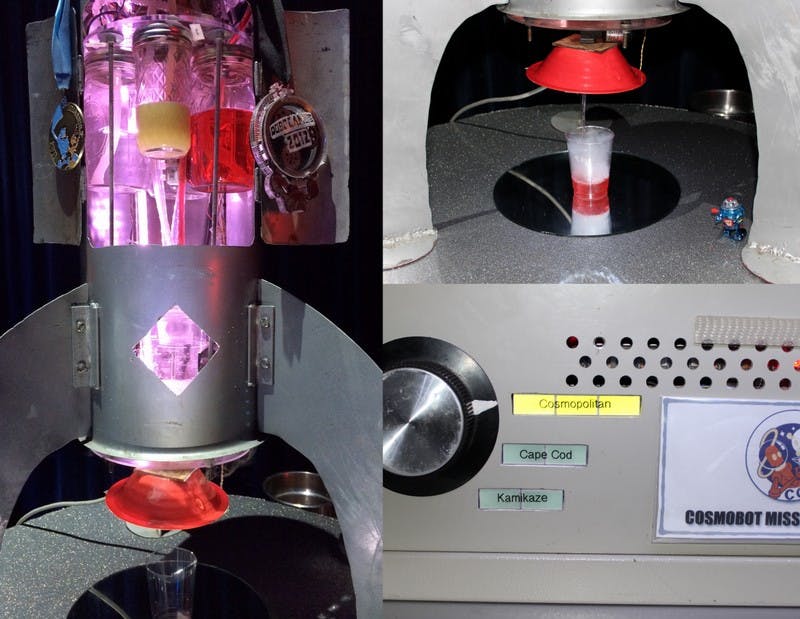
I think my cosmo tastes delicious. I shake Sam’s hand, thank him for the drink and walk away slightly unsettled.
Across the floor from Cosmobot is the N.E. Bree-8, which looks like a row of bongs. The machine consists of a lineup of liquor bottles outfitted with surgical tubing connecting each bottle to a series of switches and valves above a long conveyor belt carrying a small plastic cup back and forth, stopping briefly at the various spirits and mixers.
“These guys are having drama,” my girlfriend says to me as we approach. The four guys who make up the N.E. Bree-8 team—Will Fischer, Sam Horn, Mark Stevens and Sagar Mittal—are all wearing white lab coats and serious expressions. One team member, seated before the conveyor belt holding a laptop, is flanked by two others who lean in, squinting their eyes and pointing at the screen. The fourth member of the team, Sam Horn, stands off to the side, surveying. I decide to check in on morale.
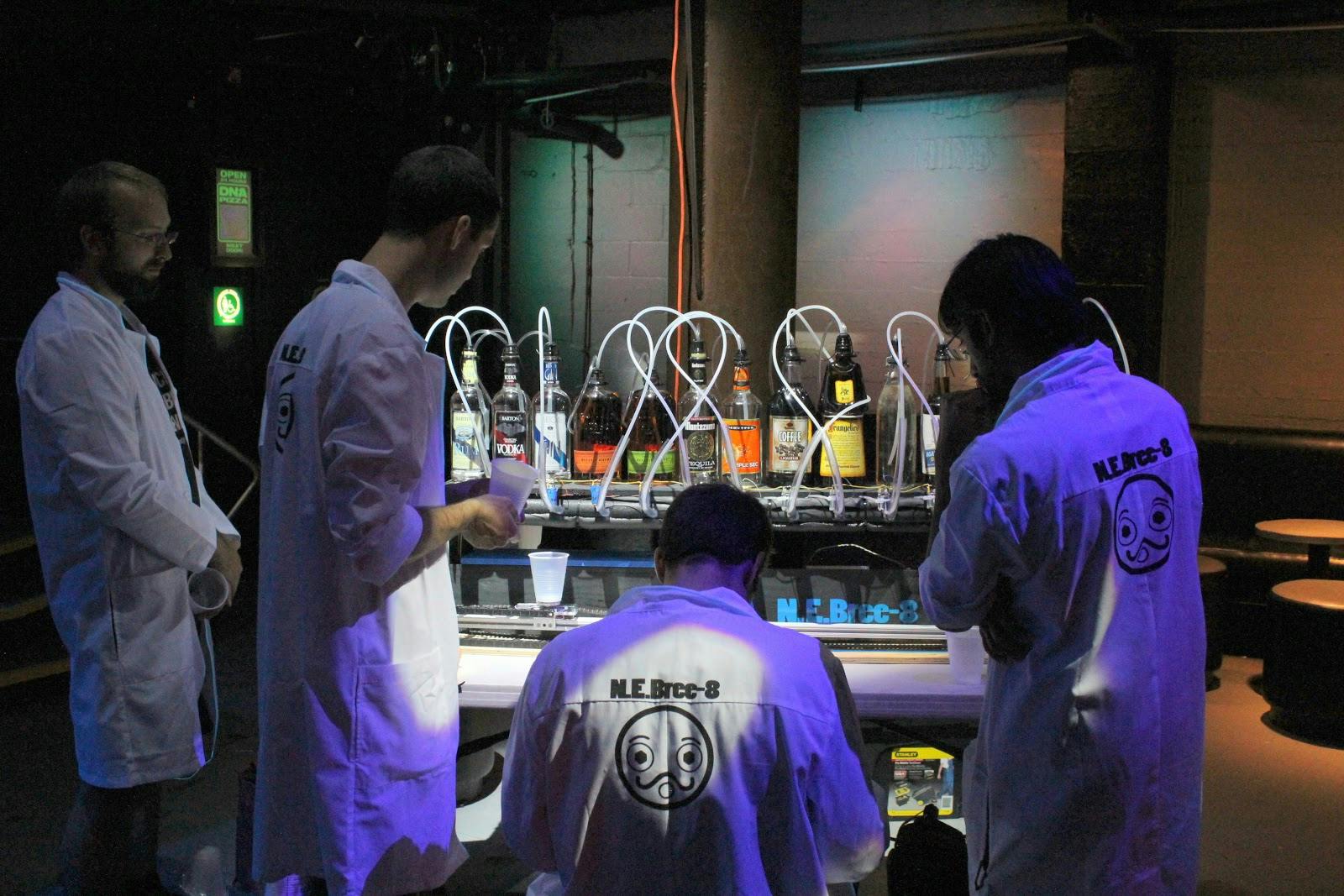
“It’s fine,” he says trying to sound casual. “All we’re doing right now is calibrating. This one valve wasn’t opening.” He points to the Agnostura bitters at the end of the line. Will and Mark met years ago in their high school robotics club. Sam tells me that the two of them built the body of the robot, and the other two built the brain. All of this happened three months ago.
Four of the machine’s spouts start spontaneously pouring into nothing. (This is not the first or last time that alcohol will be spilled by robots this night).
“So let’s say I order a Manhattan,” I offer while eyeing the booze spilling liberally all over the conveyor belt. “What happens.” “What’s in a Manhattan?” Sam replies. I list the ingredients for him while fighting the urge to back away slowly at this question.
Suddenly another member of the N.E. Bree-8 team steps into view, sipping from a test drink he’s made to see if the bot’s bitters valve is functioning properly again: “OH GOD, UGH” he sputters.
“We tried to make it smart,” Sam continues unphased, “so it goes from largest amount to smallest amount, slowly down the line.”
“It tastes like punishment,” the other team member winces, wiping his mouth on the back of his lab coat sleeve.
Without skipping a beat, Sam goes on: “The interface is pre-programmed with common drinks, and the coolest part is that it can think for you and come up with other drinks on the fly.” Sam tells me that the random feature will make you a drink, either sweet or sour, based on mixology ratios. Earlier that night his girlfriend had a drink made of coffee, lime, and rum, which tasted better than expected. “Better than expected” is, Sam says, consistent feedback from the random drink customers.
“6:00pm, already buzzed,” my notebook reads.
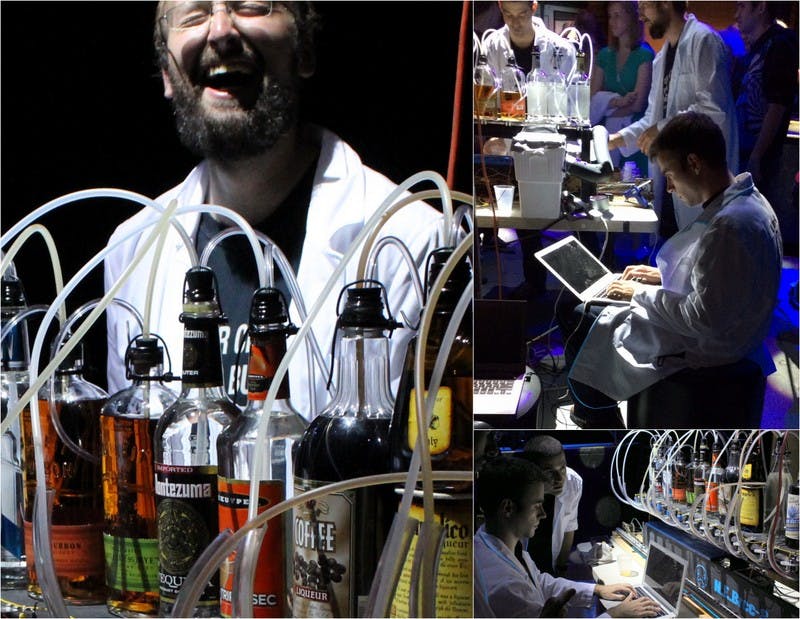
We make our way upstairs to the second level of the bar, which boasts the stickiest floor I’ve felt outside of a pride event. Six bots are on display, but Karen is, distressingly, not among them. “Where’s Karen?” I wonder, not for the last time.
Instead I meet Tipsy Bot. Tipsy Bot (nee Tipsy Train) is an adorable, LEGO-based robot that has an equally adorable LEGO-based sign. Anthony, Tipsy Bot’s maker, used to work at LEGO on their robotics line called Mindstorms and uses the leftover parts strewn around his house to make his own projects. Anthony is wearing a black T-shirt that reads ROBOT JAM in white letters. He is approachable, affable, and laughs uproariously at the slightest joke. I like Anthony, and his bot, immediately.
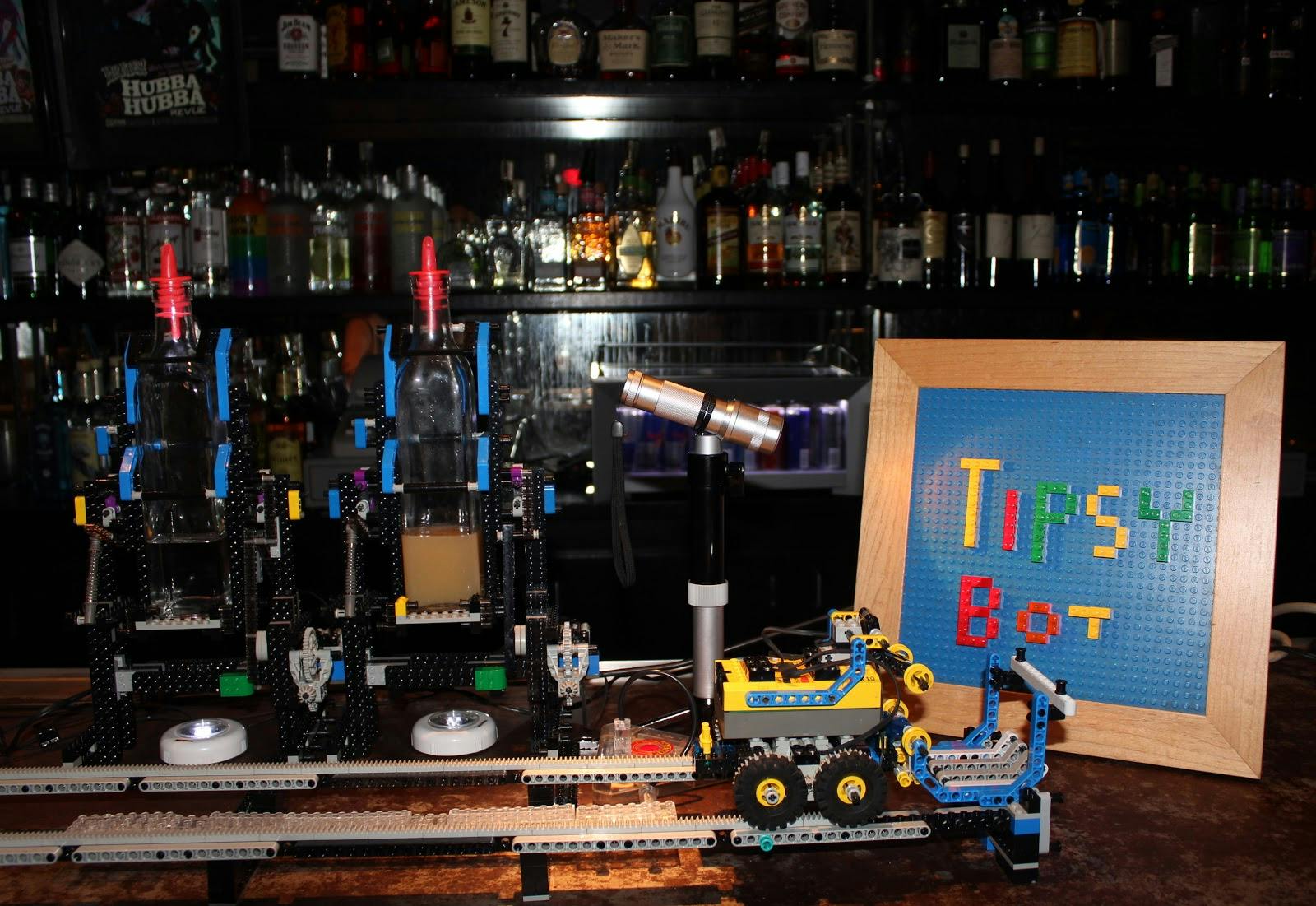
“When you want a drink from Tipsy Bot,” Anthony explains, “you just drop your cup in the little cradle and the robot does the rest.” Tipsy Bot, he continues, has two micro-controllers that control the bottles and the car, communicating through infrared messaging.
Tipsy Bot’s cradle has a rotation encoder that tracks how far it’s gone, and when it gets to the first bottle it sends an infrared message signaling to the second controller that it’s OK to pour. When the second controller is done pouring it sends a signal to the first, then the car moves and the process repeats.
“When you were testing out the Tipsy Bot,” I ask, “how wasted did you get on a scale of 1 to 10, 0 being totally sober and 10 being ‘in a ditch poking berries up your nose’?” “I’ve gotten to an eight,” Anthony confesses. “Did you have friends helping you, or were you solo?” I inquire. “The first time I was solo, which is how I got to an eight.”
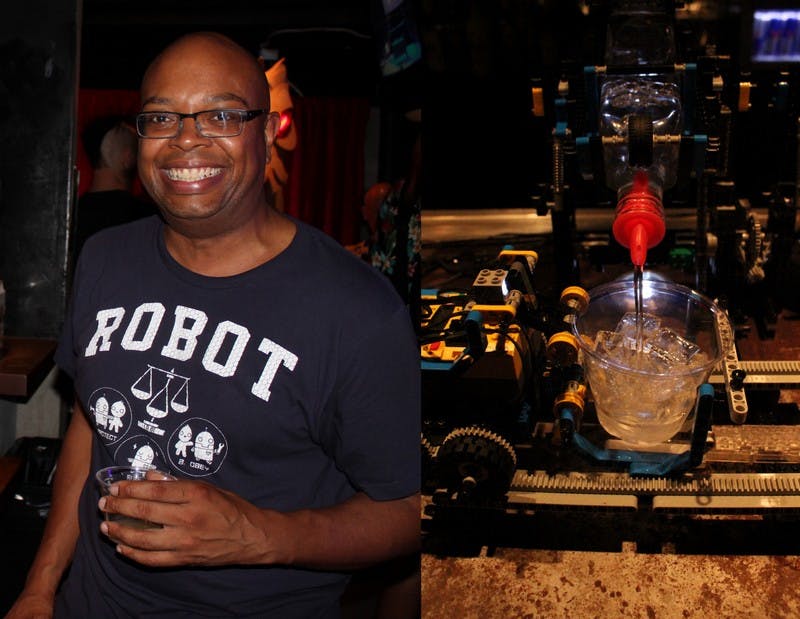
The rest of the floor boasts an impressive array of bots: Tiki Bot, a massive Mai Tai generator gorgeously built from laser-cut wood that uses an electromechanical computer with a 1RPM motor that mechanically flips a switch allowing the ingredients into a shaker, then shakes and pours the drink through a chilling coil. Matthew Dockrey’s Cocktail Engine uses an entirely analog system of punchcards, electrical contacts, bicycle chains, and gravity to create drinks, and looks really cool doing it.
Bartendro is a tablet-controlled bot that generates a drink menu based on which ingredients are loaded into the machine, and offers a trending tab to allow the user to select from popular drinks. Peristaltic pumps squeeze the tubes connected to the liquor bottles and create a vacuum that draws the liquid up, then magnetized sensors behind the rollers measure how much booze is being dispensed based on revolution. It looks like a time-travel machine. I don’t have a chance to try a drink from Bartendro because the tablet starts displaying an error message in the middle of the interview.
“WHERE’S KAREN???” my notebook screams in nearly-unintelligible all-caps. It is 8:00pm.
The evening proceeds to the judging, with an honorable mention going to N.E. Bree-8 for its random feature, third place to Tiki Bot, second to Cosmobot, and first place to Bartendro, which the judges agree they’d like to have in their own apartments. There is much rejoicing.
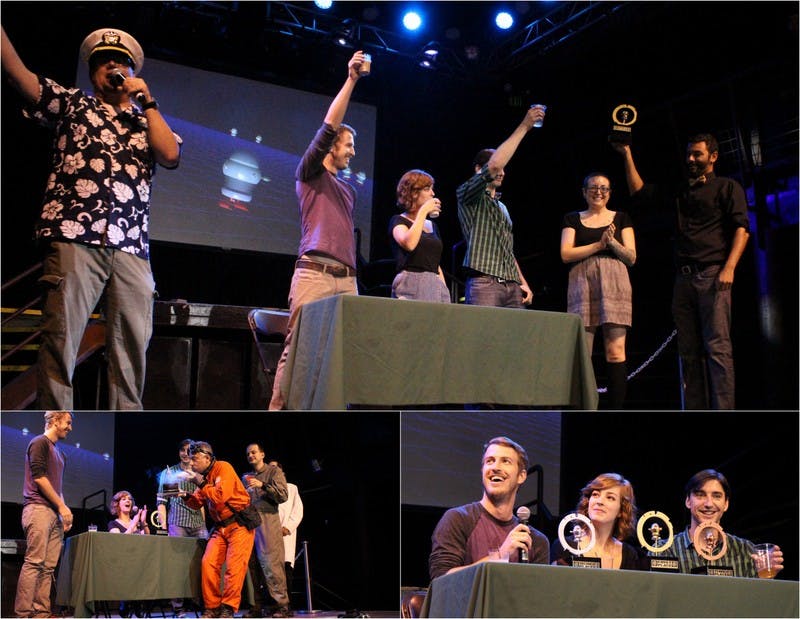
As I make my way around the room interacting with the bots and their makers, I realize that I’m equal parts amazed, amused and, if I’m being totally honest, a bit lonely. There’s something about a robot making you a drink that feels a bit pharmaceutical, in a way that is both obvious and surprising. The most positive experiences I have throughout the evening are with bots that allow me to interact with them, and with botmakers who are inviting and accessible. Cosmobot’s big red button, chunky dial, and whimsical Mystery Science Theater 3000 -vibe that touches on my childhood curiosities; TipsyBot’s user-friendly simplicity and charming mastermind—I’m drawn to the bots and botmakers that invite me in. As inarguably cool and impressive as the robot-bartenders are, there’s something to be said about a participatory element that humanizes the drinking experience. Or maybe I’ve just had a few and want to talk about my feelings.
I make my way back upstairs. I wonder about Karen. Instead, I find myself back at Tipsy Bot’s bar.
“If I told Tipsy Bot my problems, would he care?” I ask Anthony. “He doesn’t say much, but he cares,” Anthony assures me. “How do you know he cares?” I counter. “He’s LEGO!”
Emboldened, I belly-up to the bar as Tipsy Bot starts in on my drink. “I just need a little direction,” I start. “I’m feeling a bit confused about where to go next.” Tipsy Bot whirs on, undeterred. “What do you think I should do?” I desperately entreat.
Tipsy Bot finishes my drink and, wordlessly, I take the cup from its cradle. We sit in mutual silence.
What can a robot bartender offer that a human bartender can’t? “Consistency,” says one of the night’s attendees. “It’ll be the same drink again and again, for better or for worse. It might be horrible but I’m going to get the same horrible every time.
“Sometimes you just need someone to hand you a drink,” my girlfriend observes, as we head out into the night.
Photo via Marnie Joyce (CC BY 2.0)

